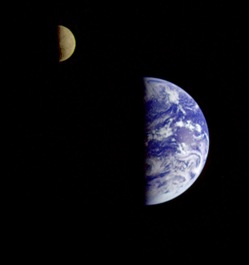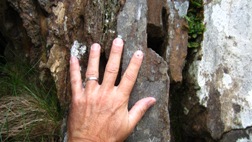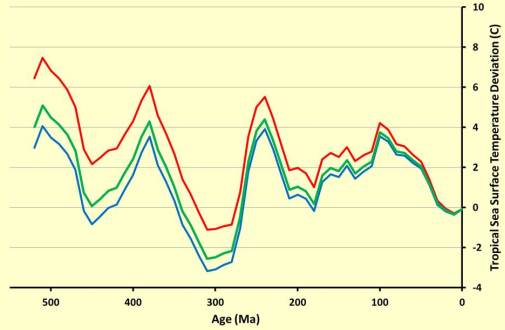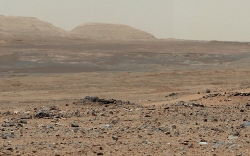Could our planet, with its complex biosphere, be one of the weirdest places in the Universe? Dave Waltham investigates...
 Such a view would seem to swim against the Copernican tide of the last half-millennium but, as I will argue, it is a perfectly reasonable position to hold. Furthermore, we geologists cannot claim to have any real understanding of our planet if we cannot answer this one simple question: Is Earth a fairly ‘typical’ world? Fortunately, if we look down rather than up, a tentative answer can be found because the four-billion-year record of life and environmental change revealed by palaeontology and geochemistry holds important clues.
Such a view would seem to swim against the Copernican tide of the last half-millennium but, as I will argue, it is a perfectly reasonable position to hold. Furthermore, we geologists cannot claim to have any real understanding of our planet if we cannot answer this one simple question: Is Earth a fairly ‘typical’ world? Fortunately, if we look down rather than up, a tentative answer can be found because the four-billion-year record of life and environmental change revealed by palaeontology and geochemistry holds important clues.
Picture: The presence of a large Moon is just one of many rare properties that may help make our planet unusually habitable (image courtesy NASA).
Before looking at this evidence I need to introduce the idea of ‘anthropic selection’ - a concept that, in my view, is as central to a proper understanding of our world as plate-tectonics. Anthropic selection is a form of observational bias, the frequently encountered difficulty that what you see is not representative of what is actually there.
For example, hard rocks stick out while softer ones erode giving a biased view of the lithologies present in any field area with less than 100% exposure. In precisely the same way, a strong observational bias occurs because it is only possible for us to inhabit a habitable planet. Brandon Carter, the man who coined the term, put it in a beautifully simple way – ‘what we observe must be compatible with our existence as observers’. Hence, if an unusual combination of circumstances is needed for a planet to produce a complex biosphere, Earth must be one of those rare and peculiar worlds that ‘got lucky’.
Rarely Done Planets
When I say that Earth may be rare, I really do mean rare. Planets that are, say, ‘one in a trillion’ might be common by comparison.
The number of planets in the Universe is so immense that even worlds much more improbable than this will still crop up many times. Thanks to NASA’s Kepler mission we are pretty certain that most stars have exoplanets orbiting them and there are about 1022 stars in the visible Universe. To get a feel for this huge number, imagine a pint glass filled with fine sand. That glass will hold about two billion grains, so you would need a hundred pints to hold as many sand grains as there are stars in our galaxy. To get 1022 grains, you’d need a box of fine sand a mile long by a mile high by a mile wide.
Moreover, if cosmologists are correct with their ‘inflationary’ models of the Universe, the actual Universe is at least a billion times bigger than the part we can see, since the initial, super-luminal expansion in these models pushes most of the Universe well beyond our cosmic horizon. (In fact, even non-inflationary cosmologies allow the Universe to be far bigger than the part we can see, but inflationary models make this inevitable rather than merely possible.) Given the huge numbers of worlds in a Universe as immense as this, there are going to be some pretty bizarre planets scattered through the Cosmos. Earth may well be one of those space oddities.
The undeniable fact that Earth must have what it takes to produce intelligent life (even if that involves fantastically rare characteristics) has quite unexpected consequences. For example we cannot deduce, from the relatively rapid appearance of life on Earth, that life emerges quickly and inevitably on any suitable world. On Earth it has taken life around four billion years to evolve intelligent observers and, as a consequence of the remorselessly increasing luminosity of the Sun, our planet will probably only be habitable for about one billion more years.
Sentient beings

An early start for life may not be the only Earth property that could turn out to be a rare but necessary precondition for our own existence. Earth’s strong magnetic field (which shields us from the solar wind) and the existence of plate-tectonics (which, among other things, helps regulate climate) both have beneficial influences on our biosphere and could be rare on other worlds.
Picture: Neproterozoic deposits at Strom Ness, Shetland. My hand spans a global temperature change that, by some estimates, went from -50 degrees C to +50 degrees C in just a few thousand years. If this was normal for the Earth, rather than an aberration, we wouldn’t be here to talk about it.
To many this seems a profoundly odd, back-to-front and even unscientific way of looking at things. Indeed, when such ideas are phrased carelessly it almost smacks of predestination (‘our planet has plate tectonics because it was necessary for our existence’). But the fact that words need to be chosen carefully does not invalidate the idea. Indeed, as geologists, we are more used to this way of thinking than most scientists, since the interpretation of outcrops follows a similar logic: what can I deduce, given the observed end-state? It’s just that, in the case of anthropic selection, the key observational constraint is our own existence. The possible paths to that end-state may be very peculiar ones.
Climate Control
Of all the Earth's potential oddities, one has particularly caught my attention. What has allowed its climate to be continuously life-friendly for four billion years? This is not a new mystery. It may already be familiar to readers of Geoscientist as the ‘Faint Young Sun Paradox’. As our Sun has aged it has become roughly 10% more luminous every billion years and, given that Earth was already warm enough for liquid water four billion years ago, it should now have become an overheated hell-hole with no liquid water at all. So, as the Sun has warmed, there has been a compensating fall in greenhouse gases and/or a compensating increase in Earth’s albedo. Why did this fortunate circumstance happen?

Diagram:Tropical sea surface temperature fluctuations through the Phanerozoic (after Veizer et al, 1999). What’s really interesting is how little variation there is (roughly ±1%).
The cycle is completed, thanks to plate tectonics, when carbon dioxide is liberated from limestone either during subduction-driven volcanism or when it is uplifted and, ironically, dissolved by acid rain. Climate control emerges because the silicate-weathering part of this cycle is boosted when the world is warmer and wetter, leading to simple negative feedback; carbon dioxide levels fall when the Earth is warm, and rise when it is cold.
There is little doubt that this feedback mechanism operates on our planet. The question is, is it enough to account for Earth's multi-billion-year habitability? The evidence is fragmentary and controversial, but it all points the same way: silicate weathering’s negative-feedback is not strong enough to overcome the positive-feedback produced by water.
This positive feedback occurs because water turns into a strong greenhouse gas when evaporated and a highly reflective solid when cooled. A warmed Earth has more water vapour and a stronger greenhouse effect (which enhances the warming) while a cooled Earth has more ice and increased albedo (which enhances cooling). These positive feedback effects seem to be stronger than the negative feedback produced by silicate weathering and so the net feedback in our climate system is positive.
Gaia vs Goldilocks
 Picture: Burrator, Dartmoor. Weathering of igneous rocks, by rainwater containing atmospheric CO2, helps stabilize temperatures on geological timescales but is this process strong enough to explain four billion years of good weather? So what is the evidence that silicate weathering feedback is too feeble to account for Earth's four billion years of good weather? Firstly, as recently reviewed in Nature (see Further Reading), estimates of long-term climate sensitivity are in the range 0.3-1.9 K W-1 m2. This figure describes how much warmer the Earth gets when additional heating occurs (e.g. because of increased solar brightness, decreased albedo or enhanced greenhouse gases) and was derived from 22 studies of a variety of palaeoclimatic events ranging from the last glacial maximum through to the entire Phanerozoic.
Picture: Burrator, Dartmoor. Weathering of igneous rocks, by rainwater containing atmospheric CO2, helps stabilize temperatures on geological timescales but is this process strong enough to explain four billion years of good weather? So what is the evidence that silicate weathering feedback is too feeble to account for Earth's four billion years of good weather? Firstly, as recently reviewed in Nature (see Further Reading), estimates of long-term climate sensitivity are in the range 0.3-1.9 K W-1 m2. This figure describes how much warmer the Earth gets when additional heating occurs (e.g. because of increased solar brightness, decreased albedo or enhanced greenhouse gases) and was derived from 22 studies of a variety of palaeoclimatic events ranging from the last glacial maximum through to the entire Phanerozoic.
However, the Planck response (i.e. the value predicted if there were no feedbacks) is only 0.3 K W
-1 m
2 - which corresponds to the very lowest value consistent with these studies. The existence of significant negative feedback is therefore ruled out for at least the last 65 million years, and possibly for the entire Phanerozoic.
On longer timescales it is notable that temperature proxies (e.g. oxygen-isotopes in shells and in chert, carbon-isotopes, ice-rafted debris, Tex86, thermophyllic archaea) all suggest that the Earth has generally cooled through time. Of course there have been times when it was even colder than now (notably during late Proterozoic ‘Snowball Earth’ episodes) but significant glaciations are brief, rare events and the general temperature trend since the Archaean is, as far as we can tell from sparse and ambiguous data, one of gradual cooling.
This is very odd! Even strong negative feedback would only moderate solar-induced warming; it shouldn’t reverse it into a cooling. It’s not physically impossible that the Earth’s climate has behaved in this way and it’s worth noting that interstellar gas-clouds do have a negative heat capacity (if you put energy in, they expand and cool) but it is, to say the least, unlikely that the Earth has a climate system that has repeatedly and consistently become colder as a response to gradually increasing heat from our star.
 Picture: Continuous habitability is not guaranteed even for a planet, such as Mars, which starts off warm and wet (image courtesy NASA).
Picture: Continuous habitability is not guaranteed even for a planet, such as Mars, which starts off warm and wet (image courtesy NASA).
A more likely explanation for the apparent cooling is that it is an artefact of poor data. However, even if this is true, I am not aware of any data that indicate the expected significant warming over the billions of years of Earth’s existence. Insolation has increased by 90Wm-2 since the Earth was young and mean global temperatures (assuming no net-feedback) should have risen 30°C. Indeed, if modern climate sensitivity had held throughout Earth’s history, temperatures would have risen by 100°C or more, and I doubt if anyone would argue for mean temperatures below -85°C in the Archaean. To get a temperature rise small enough for it to be hidden from us, the net climate-feedback on multi-billion-year scales would have to be strongly negative; but there is no obvious reason why silicate weathering should have been substantially stronger in the distant past than it is today.
Life
Something other than silicate weathering is heavily influencing the multi-billion-year climate evolution of our world; and that “something” is probably life.
As many have pointed out, the continuous evolution of our biosphere has had major climatic impacts. Before the ‘great oxygenation’, beginning about 2.4 billion years ago, our atmosphere almost certainly contained large amounts of biogenic methane - a potent greenhouse gas. A more recent example is the evolution of land plants, about 450 million years ago, which enhanced silicate weathering, accelerated rates of organic burial and changed continental reflectivity.
These produced changes in atmospheric composition and global albedo which, in turn, altered global mean temperatures. Examples like these make it all but undeniable that life has influenced climate. Moreover, in the very long term, the effects have generally been beneficial to life since they frequently produced a biologically mediated cooling which counteracted the warming influence of solar evolution.
This naturally brings me to the Gaia hypothesis that life has continuously modified the Earth’s environment for its own benefit. Let me be blunt. I think Gaia is wrong and that it has confused cause and effect. Rather than a complex biosphere stabilising the climate, a reasonably stable climate was a precondition for the emergence of a complex biosphere. We’re back to anthropic selection; only those planets which, by chance, have rates of biological and geological evolution that cancel out solar evolution, can remain habitable long enough for intelligent observers to arise.
Earth is a ‘Goldilocks planet’, where everything was, purely by good fortune, ‘just right’. This explains naturally why the cooling seems to have marginally exceeded the warming. The residual trend, after solar-warming was roughly cancelled by Earth-cooling, could have either been a slight warming or a slight cooling. On Earth, if we provisionally accept the data, it just happens to have been a cooling.
So What?
This climate example illustrates particularly well why I claimed earlier that anthropic selection is as crucial as plate tectonics for understanding of our world. It is right and proper that, having recognised the existence of the ‘faint young Sun paradox’, we should look for climate stabilising mechanisms to explain it. However, if we fail to find such processes, it may be because there are none to find.
On most Earth-like worlds, life does not survive long enough or develop far enough to produce sentient beings. Instead, it is either fried by an ever-warming Sun or frozen by biological and geological processes which have, all too rapidly, stripped the atmosphere of life-sustaining greenhouse gases. Only those worlds which, entirely by chance, get the balance right can go on to produce observers. There is no climate control, there is only good luck; good luck which is highly improbable but, nonetheless inevitable on many worlds in a Universe as immense as ours.
All of this is highly contentious. After reading this article you may well wish to send a harshly worded letter to the Editor of Geoscientist decrying his poor judgement in allowing publication. You will probably want to tell him that much of the data I have used is of questionable reliability and that other explanations for Earth’s continuous habitability are possible (not least, the Gaia hypothesis itself). Can I suggest an alternative to such a missive?
I a year’s time (11 November 2015), the Geological Society of London will hold a conference on The Puzzle of Earth’s Uninterrupted Habitability convened by myself and Graham Shields-Zhou. So, rather than write a letter, write an abstract! I look forward to reading it because I always learn a great deal from those who disagree with me (including Graham). Naturally, I will also enjoy reading abstracts that support my views.
Further Reading
For a broader range of views on these topics:
- Kasting, J, 2010. How to Find a Habitable Planet. Princeton University Press.
- Lenton, T & Watson, A., 2011. Revolutions that Made the Earth. Oxford University Press.
- PALAEOSENS Project Members, 2012. Making sense of palaeoclimate sensitivity, Nature 491, 683-691.
- Schwartzman, 1999. Life, Temperature, and the Earth. Columbia University Press, New York.
- Tyrrell, T, 2013. On Gaia. Princeton University Press, Princeton.
- Ward, P & Brownlee, ., 2000. Rare Earth. Copernicus Books.
The ideas presented in this feature are discussed at length in Dave Waltham’s provocative new book, Lucky Planet, published by Icon Books, and
reviewed in this issue Editor